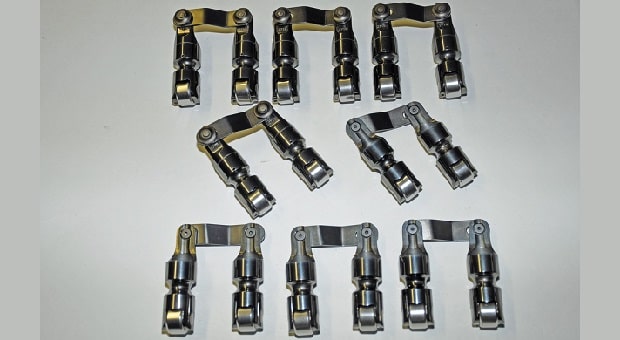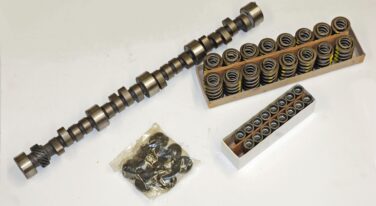
Jesel’s Solid Tie Bar Roller Lifters Part 2
Click Here to Begin Slideshow
In our last segment, we presented an overview on (Jesel Valvetrain’s over-the-top lineup of solid roller lifters. If you recall, Jesel has considerable experience building lifters for all sorts of motorsports activities, but perhaps the most demanding application where they have considerable expertise is endurance racing. Here, roller cam engines are run at W-O-T for hours on end. A lifter simply cannot be allowed to expire, because that certainly signals the end of the race. We also examined how Jesel incorporates internal oiling circuits and how they keep production machining tolerances to within 0.0002-inch! This is serious stuff and the lifters from these folks prove to be serious parts. But that’s not the end of it. There’s a bunch more to the Jesel roller lifter. Check it out:
Jesel’s solid body lifters are designed with a pushrod seat machined directly into the lifter body; there is no added seat to work loose. At the same time, they dropped the lifter seat down into the lifter body. What’s the reason for that? Easy - by moving the seat down in the body, the pushrod pivot point is moved closer to the roller axle. This means there is less leverage to rock the lifter in the bore. Jesel points out this relationship: “Think of it this way; if you’re trying to tip something over, the higher you push, the easier it gets”.
The actual lifter wheel rolls on bearings. Wait a minute! Haven’t we been told that bushings are the hot setup? That happens to be a modern racing myth (remember the “hype” we spoke of earlier?). Jesel has spent a lot of time and money investigating the roller wheel and bearing types along with the axle. Bushings tend to add friction and can, in certain instances, also contribute to cam wear by a significant margin. The truth of the matter is, in the vast majority of applications where the speeds and loads on the roller tend to be extremely high, Jesel’s take on using a needle-bearing roller is critical. Here’s why - Jesel notes: “Unlike a rod or main bearing, there is not enough oil pressure available to a lifter roller to sustain an oil film needed between an axle and bushing to keep it from galling or wearing.”
When designing the axle for all of their lifters, Jesel came up with an internal locking pin that secures the axle to the body. With this configuration, external snap rings and spirolocs that occasionally come loose causing severe engine carnage are completely eliminated.
As far as the size of the roller is concerned, bigger really does translate into better. Once the diameter is increased, the roller becomes stronger. This is due to an increased cross-sectional area between the I.D. and the O.D. of the roller. Furthermore, a larger diameter roller rotates more slowly and reduces the loads needed to open the valve train. It may be necessary to rethink the cam specs when using a larger diameter roller due to an increase in duration. Jesel notes that a larger diameter roller may also allow you to get more aggressive with the opening ramp design of the camshaft.
As the lifter body diameter is increased, the diameter of the roller can be increased over stock. Jesel lifter sets are available in 0.842-inch, 0.875-inch, 0.905-inch and 0.937-inch diameters for most popular OEM and aftermarket racing engines. Lifters with a 0.842-inch and a 0.875-inch diameter make use of a 0.760-inch diameter roller with a 0.405-inch needle bearing length.
The larger 0.905-inch diameter lifters (as shown in the accompanying photos) have a 0.820-inch diameter roller while the 0.937-inch diameter lifters have a larger roller yet of 0.850-inch diameter roller. Both of the big diameter lifters incorporate a 0.450-inch needle bearing length
Finally, these lifters are available in a variety of pushrod offsets for various engine combinations. This is particularly important if you have something like an aftermarket spread port head combination.
As you can see, there are a lot of differences in lifters. There’s also quite a bit of misinformation and hype associated with roller lifters. Some of it is right, but a lot of it is wrong. That’s why Jesel’s lifters aren’t exactly a simple “drop in the bucket.” Check out the accompanying photos and captions for more information.
In our last segment, we presented an overview on (Jesel Valvetrain’s over-the-top lineup of solid roller lifters. If you recall, Jesel has considerable experience building lifters for all sorts of motorsports activities, but perhaps the most demanding application where they have considerable expertise is endurance racing. Here, roller cam engines are run at W-O-T for hours on end. A lifter simply cannot be allowed to expire, because that certainly signals the end of the race. We also examined how Jesel incorporates internal oiling circuits and how they keep production machining tolerances to within 0.0002-inch! This is serious stuff and the lifters from these folks prove to be serious parts. But that’s not the end of it. There’s a bunch more to the Jesel roller lifter. Check it out:
Jesel’s solid body lifters are designed with a pushrod seat machined directly into the lifter body; there is no added seat to work loose. At the same time, they dropped the lifter seat down into the lifter body. What’s the reason for that? Easy - by moving the seat down in the body, the pushrod pivot point is moved closer to the roller axle. This means there is less leverage to rock the lifter in the bore. Jesel points out this relationship: “Think of it this way; if you’re trying to tip something over, the higher you push, the easier it gets”.
The actual lifter wheel rolls on bearings. Wait a minute! Haven’t we been told that bushings are the hot setup? That happens to be a modern racing myth (remember the “hype” we spoke of earlier?). Jesel has spent a lot of time and money investigating the roller wheel and bearing types along with the axle. Bushings tend to add friction and can, in certain instances, also contribute to cam wear by a significant margin. The truth of the matter is, in the vast majority of applications where the speeds and loads on the roller tend to be extremely high, Jesel’s take on using a needle-bearing roller is critical. Here’s why - Jesel notes: “Unlike a rod or main bearing, there is not enough oil pressure available to a lifter roller to sustain an oil film needed between an axle and bushing to keep it from galling or wearing.”
When designing the axle for all of their lifters, Jesel came up with an internal locking pin that secures the axle to the body. With this configuration, external snap rings and spirolocs that occasionally come loose causing severe engine carnage are completely eliminated.
As far as the size of the roller is concerned, bigger really does translate into better. Once the diameter is increased, the roller becomes stronger. This is due to an increased cross-sectional area between the I.D. and the O.D. of the roller. Furthermore, a larger diameter roller rotates more slowly and reduces the loads needed to open the valve train. It may be necessary to rethink the cam specs when using a larger diameter roller due to an increase in duration. Jesel notes that a larger diameter roller may also allow you to get more aggressive with the opening ramp design of the camshaft.
As the lifter body diameter is increased, the diameter of the roller can be increased over stock. Jesel lifter sets are available in 0.842-inch, 0.875-inch, 0.905-inch and 0.937-inch diameters for most popular OEM and aftermarket racing engines. Lifters with a 0.842-inch and a 0.875-inch diameter make use of a 0.760-inch diameter roller with a 0.405-inch needle bearing length.
The larger 0.905-inch diameter lifters (as shown in the accompanying photos) have a 0.820-inch diameter roller while the 0.937-inch diameter lifters have a larger roller yet of 0.850-inch diameter roller. Both of the big diameter lifters incorporate a 0.450-inch needle bearing length
Finally, these lifters are available in a variety of pushrod offsets for various engine combinations. This is particularly important if you have something like an aftermarket spread port head combination.
As you can see, there are a lot of differences in lifters. There’s also quite a bit of misinformation and hype associated with roller lifters. Some of it is right, but a lot of it is wrong. That’s why Jesel’s lifters aren’t exactly a simple “drop in the bucket.” Check out the accompanying photos and captions for more information.


![[Gallery] Show us Your Mustang! Celebrating 60 Years of Mustang](https://www.racingjunk.com/news/wp-content/uploads/2024/04/Al-Liebmann-376x206.webp)

![[Gallery] Okolona Street Rods Kentuckiana V Foundation Car Show](https://www.racingjunk.com/news/wp-content/uploads/2022/04/IMG_0774-e1650040587750-376x206.jpg)
![[Gallery] Road Rats Car Show](https://www.racingjunk.com/news/wp-content/uploads/2022/05/2A-e1651770667920-376x206.jpg)
Leave a Reply